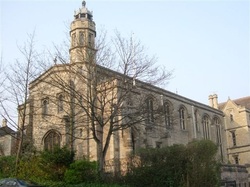The Hospital of William Browne, Stamford
For information on how and when to visit Browne's, and how to contact Browne's, go to Visit Browne's Hospital.
|
The Hospital was founded by William Browne, a rich wool merchant of Stamford, and built in 1475 in the reign of Edward IV. With his brother, John, William Browne was largely responsible for enlarging and embellishing the Church of All Saints nearby. He and his wife are believed to have lived in a house adjacent the western side of the Hospital, and so would have been parishioners of All Saints’, where brasses to three generations of their family may be seen.
In 1485 William was authorised by letters patent of Richard III to found and endow the almshouse, but after his death and that of his wife, Margaret, in 1489, the management of the Hospital passed to her brother, Thomas Stokke, Canon of York and Rector of Easton-on-the-Hill, just outside Stamford. Stokke obtained new letters patent from Henry VII in 1493 and the chapel was consecrated by the Bishop of Lincoln on 22nd December, 1494. |
|
Visitors may remember that Browne’s Hospital featured as “Middlemarch Hospital” in the film adaptation of George Eliot’s novel, “Middlemarch”, much of which was shot in Stamford. The Hospital is today home to 13 residents. The cottages around the beautiful courtyard garden were updated in 1963 to flats, each with a living room, bedroom, kitchen and bathroom. Life at Browne's was very different then; this article, entitled "50 years ago" is from the Stamford Mercury of 7 March 2014 and is reproduced here by kind permission of the Rutland & Stamford Mercury and the Stamford Mercury Archive Trust.
|
The main rooms that can be visited are: the Common Room, the Chapel, the Staircase, the Audit room and the Confrator's room.
There are Browne family connections with The Priest’s House, a National Trust property at Easton on The Hill, a mile or so away.
The Hospital is a Registered Charity, No, 221428, and is managed by a Board of Governors and Trustees, any profit from opening to the public going towards maintaining this Foundation.The Hospital or Bedehouse — a name by which it was also known — was established as a home and a house of prayer for 10 poor men and 2 poor women, with a Warden and a Confrater, both of whom were to be secular, i.e. non-monastic, priests. The statutes required attendance at chapel twice daily, where masses for the repose of the souls of the Founders were said, but on Sundays it was to All Saints’ Church that they had to go. The title “bedesman” or “beadsman” given to the poor men was derived from the beads of the rosary. With the passage of time, a new charter became necessary and this was granted by James I in 1610, and thus Browne’s Hospital may claim to be a Royal Foundation or Royal Hospital.
There are Browne family connections with The Priest’s House, a National Trust property at Easton on The Hill, a mile or so away.
The Hospital is a Registered Charity, No, 221428, and is managed by a Board of Governors and Trustees, any profit from opening to the public going towards maintaining this Foundation.The Hospital or Bedehouse — a name by which it was also known — was established as a home and a house of prayer for 10 poor men and 2 poor women, with a Warden and a Confrater, both of whom were to be secular, i.e. non-monastic, priests. The statutes required attendance at chapel twice daily, where masses for the repose of the souls of the Founders were said, but on Sundays it was to All Saints’ Church that they had to go. The title “bedesman” or “beadsman” given to the poor men was derived from the beads of the rosary. With the passage of time, a new charter became necessary and this was granted by James I in 1610, and thus Browne’s Hospital may claim to be a Royal Foundation or Royal Hospital.





